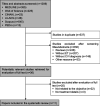The impact of exercise training on calf pump function, muscle strength, ankle range of motion, and health-related quality of life in patients with chronic venous insufficiency at different stages of severity: a systematic review
- PMID: 34093685
- PMCID: PMC8147883
- DOI: 10.1590/1677-5449.200125
The impact of exercise training on calf pump function, muscle strength, ankle range of motion, and health-related quality of life in patients with chronic venous insufficiency at different stages of severity: a systematic review
Abstract
Exercise training (ET) is an important tool in the management of patients with chronic venous insufficiency (CVI). The objective of this article was to discuss the effects of ET on the calf pump, functional parameters, and quality of life of patients with mild and advanced CVI. A systematic review was conducted and eleven studies were included. In patients with mild CVI, ET was effective for improving venous reflux, muscle strength, ankle range of motion, and quality of life. In advanced CVI patients, ET increased ejection fraction, reduced residual volume fraction, and improved muscle strength and ankle range of motion, but did not change venous reflux indices or quality of life. It is concluded that ET is effective for improving calf pump function, muscle strength, and ankle range of motion in CVI. In patients with mild CVI, additional benefits were observed in quality of life.
O treinamento físico é uma importante ferramenta no tratamento de pacientes com insuficiência venosa crônica. O objetivo foi discutir os efeitos do tratamento físico na bomba da panturrilha, os parâmetros funcionais e a qualidade de vida de pacientes com insuficiência venosa crônica leve e avançada. Uma revisão sistemática foi realizada, e 11 estudos foram incluídos. Na insuficiência venosa crônica leve, o treinamento físico foi eficaz na melhora do refluxo venoso, da força muscular, da amplitude de movimento do tornozelo e da qualidade de vida. Na insuficiência venosa crônica avançada, o treinamento físico aumentou a fração de ejeção, reduziu a fração de volume residual e melhorou a força muscular e amplitude de movimento do tornozelo, sem alterações nos índices de refluxo venoso e na qualidade de vida. Conclui-se que o treinamento físico é eficaz na melhoria da bomba da panturrilha, da força muscular e da amplitude de movimento do tornozelo na insuficiência venosa crônica. Em pacientes com insuficiência venosa crônica leve, foram encontrados benefícios adicionais na qualidade de vida.
Keywords: articular range of motion; exercise; muscle strength; quality of life; venous insufficiency.
Copyright© 2021 The authors.
Conflict of interest statement
Conflicts of interest: No conflicts of interest declared concerning the publication of this article.
Figures

Similar articles
-
Structured exercise improves calf muscle pump function in chronic venous insufficiency: a randomized trial.J Vasc Surg. 2004 Jan;39(1):79-87. doi: 10.1016/j.jvs.2003.09.036. J Vasc Surg. 2004. PMID: 14718821 Clinical Trial.
-
Effects of isokinetic calf muscle exercise program on muscle strength and venous function in patients with chronic venous insufficiency.Phlebology. 2018 May;33(4):261-266. doi: 10.1177/0268355517695401. Epub 2017 Mar 7. Phlebology. 2018. PMID: 28954574
-
Limited range of motion is a significant factor in venous ulceration.J Vasc Surg. 1995 Nov;22(5):519-23. doi: 10.1016/s0741-5214(95)70030-7. J Vasc Surg. 1995. PMID: 7494349
-
Differences in health-related quality of life in patients with mild and severe chronic venous insufficiency: A systematic review and meta-analysis.J Vasc Nurs. 2021 Dec;39(4):126-133. doi: 10.1016/j.jvn.2021.09.002. Epub 2021 Oct 20. J Vasc Nurs. 2021. PMID: 34865723
-
The calf muscle pump revisited.J Vasc Surg Venous Lymphat Disord. 2014 Jul;2(3):329-34. doi: 10.1016/j.jvsv.2013.10.053. Epub 2014 Jan 28. J Vasc Surg Venous Lymphat Disord. 2014. PMID: 26993396 Review.
Cited by
-
Brazilian guidelines on chronic venous disease of the Brazilian Society of Angiology and Vascular Surgery.J Vasc Bras. 2023 Nov 6;22:e20230064. doi: 10.1590/1677-5449.202300642. eCollection 2023. J Vasc Bras. 2023. PMID: 38021274 Free PMC article.
-
Letter to the Editor concerning "Pre-operative predictors of lower extremity swelling following total knee arthroplasty in patients with venous insufficiency and osteoarthritis".Int Orthop. 2021 Nov;45(11):3007-3008. doi: 10.1007/s00264-021-05206-y. Epub 2021 Sep 2. Int Orthop. 2021. PMID: 34476562 No abstract available.
-
Reliability and validity of specific quality of life assessment questionnaires related to chronic venous insufficiency: a systematic review.J Vasc Bras. 2022 Oct 24;21:e20210229. doi: 10.1590/1677-5449.202102292. eCollection 2022. J Vasc Bras. 2022. PMID: 36407663 Free PMC article. Review.
References
-
- Santos RFFN, Porfírio GJM, Pitta GBB. A diferença na qualidade de vida de pacientes com doença venosa crônica leve e grave. J Vasc Bras. 2009;8(2):143–147. doi: 10.1590/S1677-54492009000200008. - DOI
-
- Leal FJ, Santos LMS, Couto RC, Moraes SGP, Silva TS, Santos WR. Tratamento fisioterapêutico vascular para a doença venosa crônica: artigo de revisão. J Vasc Bras. 2016;15(1):34–43. doi: 10.1590/1677-5449.003215. - DOI
Publication types
LinkOut - more resources
Full Text Sources
